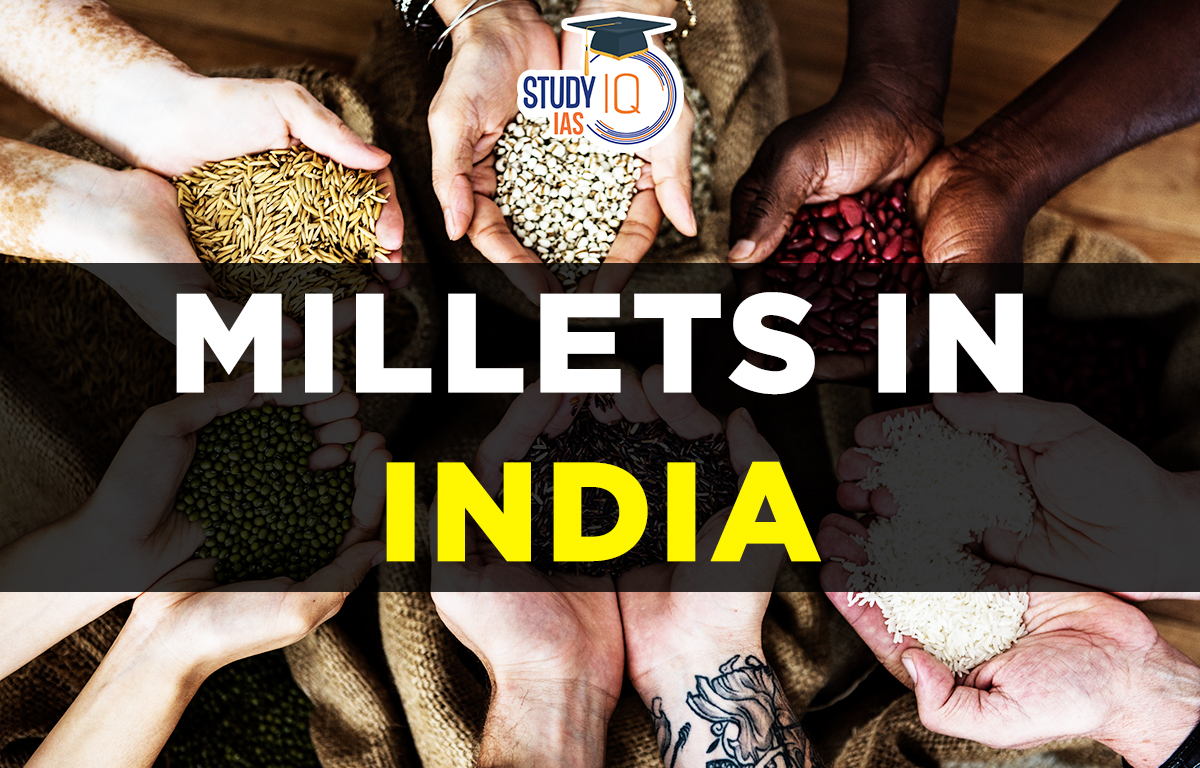Table of Contents
Context: Recent Union Budget of 2023-24 has accorded high priority to millets — grains such as jowar, bajra, ragi — citing their health benefits.
International Year of Millets (IYOM) 2023
- On March 3, 2021, the United Nations General Assembly (UNGA) adopted a resolution to declare 2023 as the International Year of Millets.
- The proposal was moved by India and was supported by 72 countries.
- Significance:
- IYOM will provide an opportunity to increase global production, efficient processing and better
- use of crop rotation and promote millets as a major component of the food basket.
- Last month, the FAO launched the IYOM in Italy and highlighted that the promotion of millets aligns with Sustainable Development Goals (SDGs) — 1, 3, 8, 12, 13 and 15.
- Political significance for India: Millet is grown mainly in low-income and developing countries in Asia and Africa, and is part of the food basket of about 60 crore people across the globe.
- By proposing the resolution to celebrate 2023 as the International Year of Millets, India pitched itself as a leader of this group.
- This is similar to the Indian initiative on the 121-nation International Solar Alliance.
About Millets
- Millet is a common term to categorize small-seeded grasses that are often termed Nutri-cereals or Dryland-cereals and includes Sorghum (Jowar), Pearl Millet (Bajra), Finger Millet (Ragi), Little Millet (Kutki), Foxtail Millet (Kakun), Proso Millet (Cheena), Barnyard Millet (Sawa), Kodo Millet (Kodon) and other millets.
- Millets are the stapled crops adapted to dry land agro-ecologies of the arid and semi-arid tropics.
- It is an important staple cereal crop for millions of smallholder dryland farmers across Sub-Saharan Africa and Asia, millets offer nutrition, resilience, income and livelihood for farmers.
- They have multiple untapped uses such as food, feed, fodder, biofuels and brewing.

India and Millets
- India produces all the nine commonly known millets.
- India is the largest producer and second largest exporter of ‘Sree Anna’ (millets) in the world.
- In India, millets are produced in most of the states characterized by low to moderate precipitation (200–800 mm rainfall).
- India recorded 27 per cent growth in millet production in 2021-22 as compared to millet production in the previous year was 15.92 MMT
Significance and Benefits of Millets
| Head | Details |
| Nutritionally Rich: |
|
| Health Benefits |
|
| Climate Resilient |
|
| Ecologically Sustainable |
|
Steps Taken by Government to Promote Millets in India
- Increase in Millet procurement of these grains under the public distribution system.
- Food regulator Food Safety and Standards Association of India (FSSAI) to formulate guidelines to include millets in the food menu of schools, hospitals, and government canteens.
- Hospitals such as the All India Institute of Medical Sciences are working to set up a “millets canteen” to produce millets-based foods.
- Ministry of Food Processing Industries has organised millet fair-cum-exhibitions in Andhra Pradesh, Bihar, and Madhya Pradesh.
- Indian Institute of Millet Research-Hyderabad will be supported as the Centre of Excellence for sharing best practices, research and technologies at the international level.
- Indian embassies in more than 140 countries will organise exhibitions, seminars, and cooked millet dish competitions.
Recommendation to Improve Millets Production in India
- Expansion of millets cultivation across the country including in non-traditional areas and enhancing their yield levels with clear cut goals by leveraging ICAR network of millets coordinating centres and ICRISAT
- Scaling up the Value Chain on Millets by replicating the pioneering efforts by ICAR institutes which have paved a pathway for reviving millets in the country through addressing backward integration
- Convergence of various departments such as NITI Aayog, APEDA, MHRD, MOFPI, MSME, etc., with DAC&FW and ICAR, can enlarge the mandate of millets promotion in the country
- Leveraging the International Year Millets for global level awareness creation and popularization by organizing various kinds of events till 2023 and in 2023 is very essential, as India is the largest producer of millets and also the prime beneficiary of millets promotion
- Incentivizing the Processing and Export of millet products for encouraging the big private companies such as ITC, Britannia, Marico, Kellogg’s, MTR, etc., to aggressively adopt millets into their product portfolio.
- Strengthening the Small and Medium Enterprises would play a pivotal role in pushing the millet products in local markets, and supply to government programs.



 100 Years of CPI: Origins, Ideology, Fre...
100 Years of CPI: Origins, Ideology, Fre...
 Santhali Language: History, Script, Cons...
Santhali Language: History, Script, Cons...
 How African Reserves Eliminated Rhino Po...
How African Reserves Eliminated Rhino Po...

























